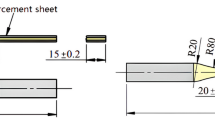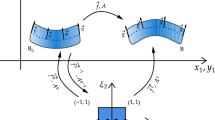Abstract
Fine asphalt mortar (FAM) affects the pavement performance of asphalt concrete (AC) significantly, especially for the FAM modified by Polymer modifiers. However, most of the previous studies mainly concentrated on the decelerated creep stage and equi-velocity creep stage, while rarely focused on the accelerated creep stage. In this paper, a developed model is proposed, coupling the Kachanov damage theory and Lemaitre rule to describe the whole stage of the creep response of modified FAM. Then this model was calibrated and validated by comparing the predicted results and measured results, which were obtained from the Uniaxial Compression Creep (UCC) test using the Dynamic Mechanics Analyzer (DMA) under various testing conditions. In addition, a novel creep instability criterion is also proposed to judge the initiation point of the accelerated creep stage. The results indicate that the developed model can characterize three-stage creep deformation behavior of all kinds FAMs completely. Compared with the traditional flow time, the novel creep instability criterion shows more consistency with the actual state of the testing specimens. Furthermore, the effects of stress levels and temperatures on the creep behavior of FAM are investigated using this novel creep instability criterion. It concludes that the creep performance of both neat and modified FAM is significantly weakened with increase of temperatures and stress levels. In addition, a stress threshold is found. If the applied stress level is higher than the threshold, creep instability would occur in a short time. Otherwise, it would be difficult to enter the accelerated creep stage.









Similar content being viewed by others
References
Wang C, Zhou X, Yuan H, Chen H, Zhou L, Fu Y (2021) Preparation and performance of UHMWP modified asphalt and its high modulus mixture. Constr Build Mater. https://doi.org/10.1016/j.conbuildmat.2021.123629
Redelius P, Soenen H (2015) Relation between bitumen chemistry and performance. Fuel 140:34–43. https://doi.org/10.1016/j.fuel.2014.09.044
Lesueur D (2009) The colloidal structure of bitumen: consequences on the rheology and on the mechanisms of bitumen modification. Adv Colloid Interface Sci 145(1–2):42–82. https://doi.org/10.1016/j.cis.2008.08.011
Hajikarimi P, Moghadas Nejad F, Khodaii A, Fini EH (2018) Introducing a stress-dependent fractional nonlinear viscoelastic model for modified asphalt binders. Constr Build Mater 183:102–113. https://doi.org/10.1016/j.conbuildmat.2018.06.166
Moreno F, Rubio MC (2013) Effect of aggregate nature on the fatigue-cracking behavior of asphalt mixes. Mater Des 47:61–67. https://doi.org/10.1016/j.matdes.2012.12.048
Gross B (1953) Mathematical structure of the theories of viscoelasticity. Hermann, Paris
Wu J (2014) Uniaxial compression creep prediction of asphalt mixture using the eshelby equivalent inclusion method. Adv Mater Res 1061–1062:410–413. https://doi.org/10.4028/www.scientific.net/AMR.1061-1062.410
Cheng YC, Li H, Li LD, Zhang YW, Wang HT, Bai YS (2019) Viscoelastic properties of asphalt mixtures with different modifiers at different temperatures based on static creep tests. Appl Sci Basel 9(20):4246. https://doi.org/10.3390/app9204246
Zhang LJ, Zhang XN, Liu X, Luo YJ (2015) Viscoelastic model of asphalt mixtures under repeated load. J Mater Civ Eng 27(10):04015007. https://doi.org/10.1061/(asce)mt.1943-5533.0001256
Pasetto M, Baldo N (2016) Numerical visco-elastoplastic constitutive modelization of creep recovery tests on hot mix asphalt. J Traffic Transp Eng (Engl Ed) 3(5):390–397. https://doi.org/10.1016/j.jtte.2016.09.009
Sun SF, Li PL, Cheng LD, Wang X, Zhang WQ (2022) Analysis of skeleton contact stability of graded aggregates system and its effect on slip creep properties of asphalt mixture. Constr Build Mater 316:125911
Yazdipanah F, Ameri M, Shahri M, Hasheminejad N, Haghshenas HF (2021) Laboratory investigation and statistical analysis of the rutting and fatigue resistance of asphalt mixtures containing crumb-rubber and wax-based warm mix asphalt additive. Constr Build Mater 309:125165. https://doi.org/10.1016/j.conbuildmat.2021.125165
Darabi MK, Huang C-W, Bazzaz M, Masad EA, Little DN (2019) Characterization and validation of the nonlinear viscoelastic-viscoplastic with hardening-relaxation constitutive relationship for asphalt mixtures. Constr Build Mater 216:648–660. https://doi.org/10.1016/j.conbuildmat.2019.04.239
Zeng F, Yang X, Bai F, Gao H (2014) Visco-elastoplastic damage constitutive model for compressed asphalt mastic. J Cent South Univ 21(10):4007–4013
Kim Y-R, Little DN (2004) Linear viscoelastic analysis of asphalt mastics. J Mater Civ Eng 16(2):122–132. https://doi.org/10.1061/(ASCE)0899-1561(2004)16:2(122)
Park SW, Kim YR (1996) A viscoelastic continuum damage model and its application to uniaxial behavior of asphalt concrete. Mech Mater 24(4):241–255. https://doi.org/10.1016/S0167-6636(96)00042-7
Zhang J, Pei J, Zhang Z (2012) Development and validation of viscoelastic-damage model for three-phase permanent deformation of dense asphalt mixture. J Mater Civ Eng 24(7):842–850. https://doi.org/10.1061/(asce)mt.1943-5533.0000467
Arabani M, Kamboozia N (2014) New achievements in visco-elastoplastic constitutive model and temperature sensitivity of glasphalt. Int J Pavement Eng 15(9):810–830. https://doi.org/10.1080/10298436.2014.893317
Gao DD, Wang PB, Li M, Luo WB (2015) Modelling of nonlinear viscoelastic creep behaviour of hot-mix asphalt. Constr Build Mater 95:329–336. https://doi.org/10.1016/j.conbuildmat.2015.07.112
Huang CS, Wang FT, Gao T, Gao DY (2018) A new viscoelastic mechanics model for the creep behaviour of fiber reinforced asphalt concrete. Frat Ed Integrita Strutt 45:108–120. https://doi.org/10.3221/igf-esis.45.09
Lagos-Varas M, Movilla-Quesada D, Arenas JP, Raposeiras AC, Castro-Fresno D, Calzada-Perez MA, Maturana J (2019) Study of the mechanical behavior of asphalt mixtures using fractional rheology to model their viscoelasticity. Constr Build Mater 200:124–134. https://doi.org/10.1016/j.conbuildmat.2018.12.073
Liang S, Luo R, Luo WB (2021) Fractional differential constitutive model for linear viscoelasticity of asphalt and asphalt mastic. Constr Build Mater. https://doi.org/10.1016/j.conbuildmat.2021.124886
Sun L, Zhu HR, Zhu YT (2013) Two-stage viscoelastic-viscoplastic damage constitutive model of asphalt mixtures. J Mater Civ Eng 25(8):958–971. https://doi.org/10.1061/(asce)mt.1943-5533.0000646
Sun L, Zhu YT (2013) A serial two-stage viscoelastic-viscoplastic constitutive model with thermodynamical consistency for characterizing time-dependent deformation behavior of asphalt concrete mixtures. Constr Build Mater 40:584–595. https://doi.org/10.1016/j.conbuildmat.2012.10.004
Zhang YJ, Liu X, Yin BY, Luo WB (2021) A nonlinear fractional viscoelastic-plastic creep model of asphalt mixture. Polymers. https://doi.org/10.3390/polym13081278
Cao W, Lacroix A, Kim YR (2022) A triaxial linear viscoelastic characterization framework for asphalt concrete based on the 2S2P1D model. Eur J Mech Solids 92:104469. https://doi.org/10.1016/j.euromechsol.2021.104469
Ye Y, Yang X, Chen C (2009) Experimental researches on visco-elastoplastic constitutive model of asphalt mastic. Constr Build Mater 23(10):3161–3165. https://doi.org/10.1016/j.conbuildmat.2009.06.023
Behbahani H, Ziari H, Kamboozia N (2016) Evaluation of the visco-elasto-plastic behavior of glasphalt mixtures through generalized and classic Burger’s models modification. Constr Build Mater 118:36–42. https://doi.org/10.1016/j.conbuildmat.2016.04.157
Goh SW, You Z (2009) A simple stepwise method to determine and evaluate the initiation of tertiary flow for asphalt mixtures under dynamic creep test. Constr Build Mater 23(11):3398–3405. https://doi.org/10.1016/j.conbuildmat.2009.06.020
Kim Y, Lee HD (2012) Performance evaluation of cold in-place recycling mixtures using emulsified asphalt based on dynamic modulus, flow number, flow time, and raveling loss. Ksce J Civ Eng 16(4):586–593. https://doi.org/10.1007/s12205-012-1376-0
Liu HQ, Luo R, Xi L, Hu LY (2020) Development of two-step secant method to interpret the flow number test data of asphalt mixtures. J Mater Civ Eng. https://doi.org/10.1061/(asce)mt.1943-5533.0003094
Wang H, Zhan SH, Liu GJ, Xiang JW (2019) The effects of asphalt migration on the flow number of asphalt mixture. Constr Build Mater 226:442–448. https://doi.org/10.1016/j.conbuildmat.2019.07.246
Yao H, You Z (2017) Performance of micro- and nano-modified asphalt mixtures through flow number and moisture susceptibility evaluations. J Test Eval 45(6):2009–2019. https://doi.org/10.1520/jte20150434
Alavi AH, Hasni H, Zaabar I, Lajnef N (2017) A new approach for modeling of flow number of asphalt mixtures. Arch Civ Mech Eng 17(2):326–335. https://doi.org/10.1016/j.acme.2016.06.004
Zhu H, Nodes J (2000) Contact based analysis of asphalt pavement with the effect of aggregate angularity. Mech Mater 32(3):193–202. https://doi.org/10.1016/S0167-6636(99)00054-X
Luo R, Hou Q (2021) Development of time-temperature-humidity superposition principle for asphalt mixtures. Mech Mater 156:103792. https://doi.org/10.1016/j.mechmat.2021.103792
Xu W, Yang S, Chu W (2006) Nonlinear Viscoelasto-Plastic rheological model (Hohai model) of rock and its engineering application. Chin J Rock Mech Eng 25(3):433–447 ((in Chinese))
Lemaitre J (1996) A course on damage mechanics. Springer, Berlin Heidelberg
Darabi MK, Abu Al-Rub RK, Little DN (2012) A continuum damage mechanics framework for modeling micro-damage healing. Int J Solids Struct 49(3–4):492–513. https://doi.org/10.1016/j.ijsolstr.2011.10.017
Hou F, Lai Y, Liu E, Luo H, Liu X (2018) A creep constitutive model for frozen soils with different contents of coarse grains. Cold Reg Sci Technol 145:119–126. https://doi.org/10.1016/j.coldregions.2017.10.013
Wang P, Xu J, Liu S, Liu S, Wang H (2016) A prediction model for the dynamic mechanical degradation of sedimentary rock after a long-term freeze-thaw weathering: considering the strain-rate effect. Cold Reg Sci Technol 131:16–23. https://doi.org/10.1016/j.coldregions.2016.08.003
Zou X, Sha A, Jiang W, Huang X (2015) Modification mechanism of high modulus asphalt binders and mixtures performance evaluation. Constr Build Mater 90:53–58. https://doi.org/10.1016/j.conbuildmat.2015.04.048
Acknowledgements
This research is supported by the National Nature Science Foundation of China (NSFC) (No. 51978073) and the Science and Technology Department of Henan Province (No.202102310263). The author would like express their sincere appreciation to the aforementioned organization. In addition, Bowei Sun wants to thank, in particular, the company, care and support from Shenxi Li over the eight years.
Author information
Authors and Affiliations
Corresponding author
Ethics declarations
Conflict of interest
The authors declare that they have no known competing financial interests or personal relationships that could have appeared to influence the work reported in this paper.
Additional information
Publisher's Note
Springer Nature remains neutral with regard to jurisdictional claims in published maps and institutional affiliations.
Rights and permissions
About this article
Cite this article
Sun, B., Hao, P., Zhang, H. et al. Establishment and verification of a developed viscoelastic damage model and creep instability criterion for modified fine asphalt mortar. Mater Struct 55, 107 (2022). https://doi.org/10.1617/s11527-022-01951-7
Received:
Accepted:
Published:
DOI: https://doi.org/10.1617/s11527-022-01951-7




